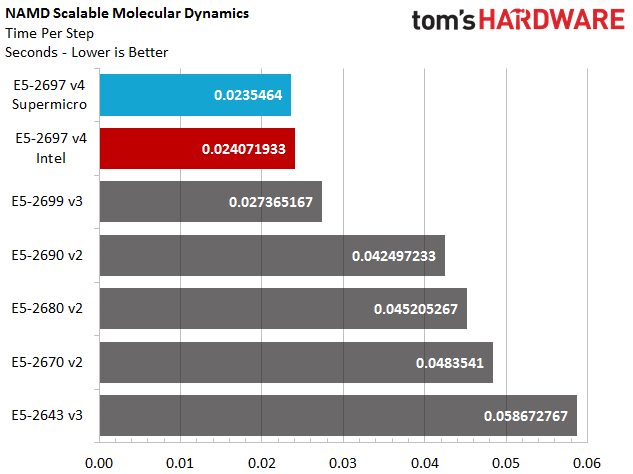Intel Xeon E5-2600 v4 Broadwell-EP Review
Why you can trust Tom's Hardware
Benchmarks
Unix Bench 5.1.3
Unix Bench is an open source GPLv2-licensed test suite that originated in 1983 at Mondash University. Byte Magazine then updated and expanded the test suite. It includes nine tests that quantify various aspects of system performance, but we focus on the Dhrystone and Whetstone metrics. The former focuses on string handling; there are no floating-point operations. Whetstone measures the speed and efficiency of floating-point operations typically employed in scientific applications.
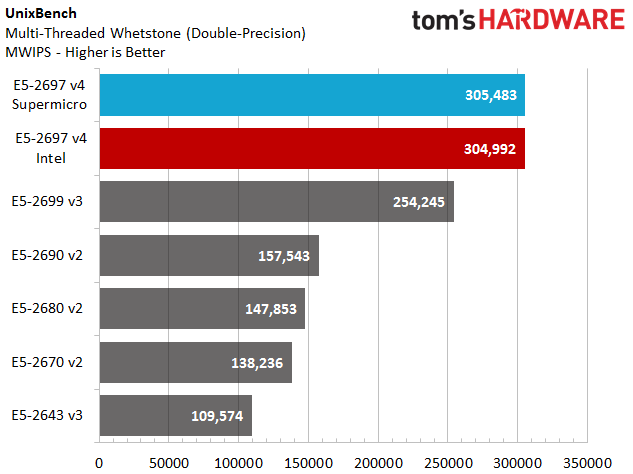
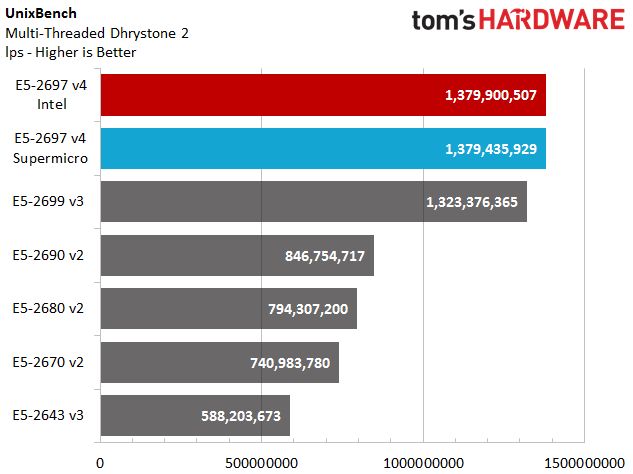
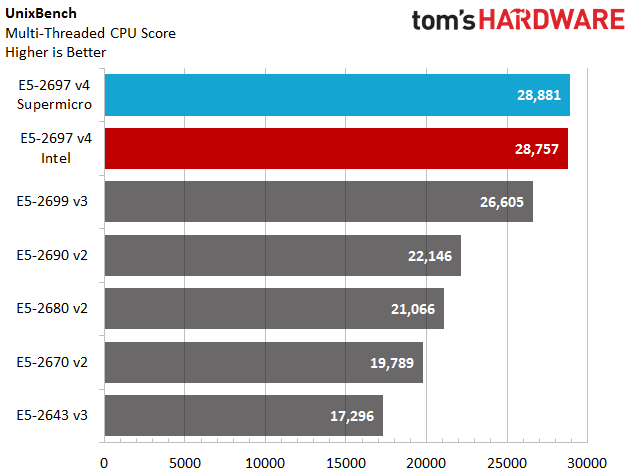
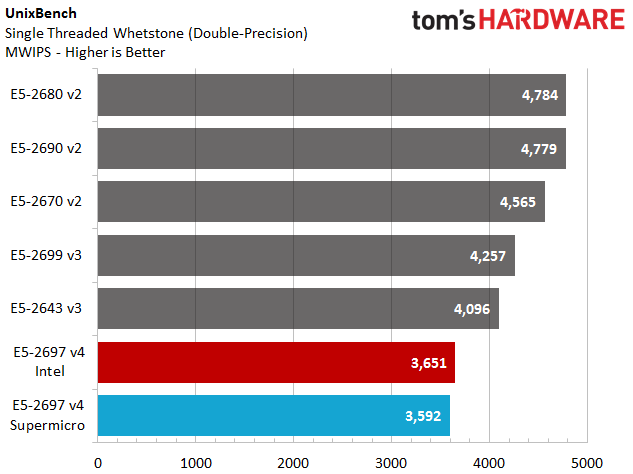

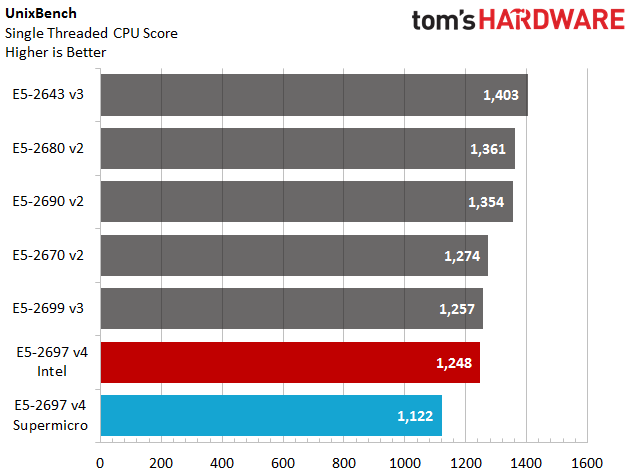
Both Xeon E5-2697 v4-based systems take a tremendous lead over the competition in our multi-threaded Whetstone test, which is impressive because the -2699 v3 features an identical core count, cache and clock rate. Apparently a big boost in IPC throughput, among other optimizations, delivers a strong performance improvement.
Conversely, the E5-2697 v4 comes crashing down to the bottom of the single-threaded Whetstone test. Both v4-powered servers muster more performance in the Dhrystone test, but still fall behind the Xeon E5-2643 v3. This is not entirely surprising; the eight-core -2643 v3 sports a higher 3.2GHz base frequency and a slightly better 3.7GHz max Turbo Core clock rate.
The Xeon E5-2643 v3's lower score in the single-threaded Whetstone test is unexpected. These results come from an average of three runs, but we retested the -2643 v3 extensively to ensure its outcome was repeatable.
NAMD Scalable Molecular Dynamics
NAMD is a parallel molecular dynamics code that performs high-performance simulations of large biomolecular systems. It's designed to test the boundaries of parallel computing by scaling up to 500,000 cores. The Theoretical and Computational Biophysics Group at the University of Illinois at Urbana-Champaign developed and maintains the project, which is the recipient of several prestigious awards.
The Xeon E5-2697 v4 easily finishes with a comfortable lead over competing CPUs in this parallel workload. The previous-gen -2643 v3 lands in last place, which aligns with our expectations due to its lower core count in comparison to the other contenders.
NAS Parallel Benchmarks
The NAS Parallel Benchmarks (NPB) are a set of programs developed by the NASA Advanced Supercomputing Division to evaluate the performance of parallel supercomputers. The test suite characterizes Computational Fluid Dynamics (CFD) applications, and NASA designed it to measure performance from smaller CFD applications up to "embarrassingly parallel" operations.
Get Tom's Hardware's best news and in-depth reviews, straight to your inbox.
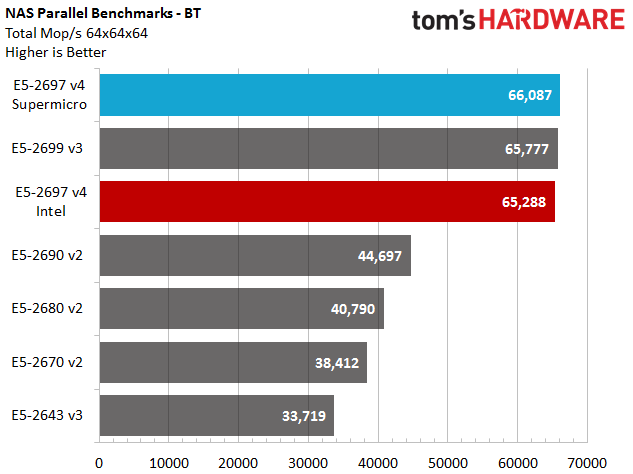
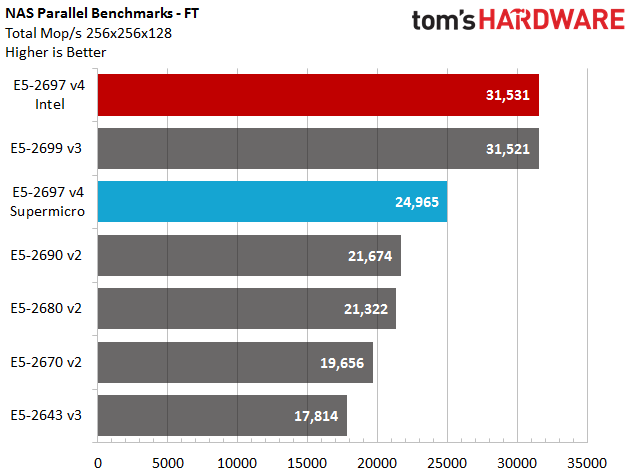
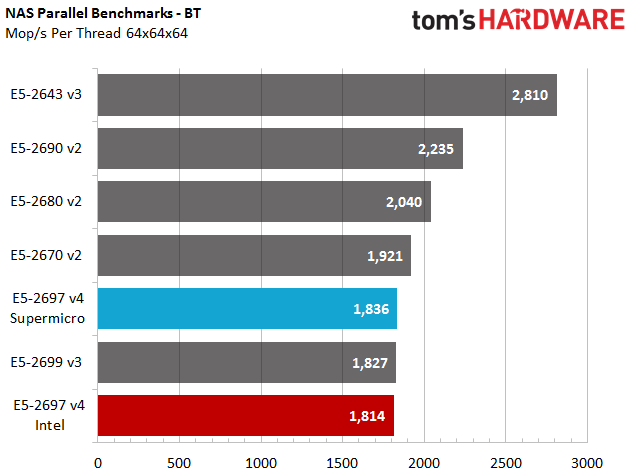
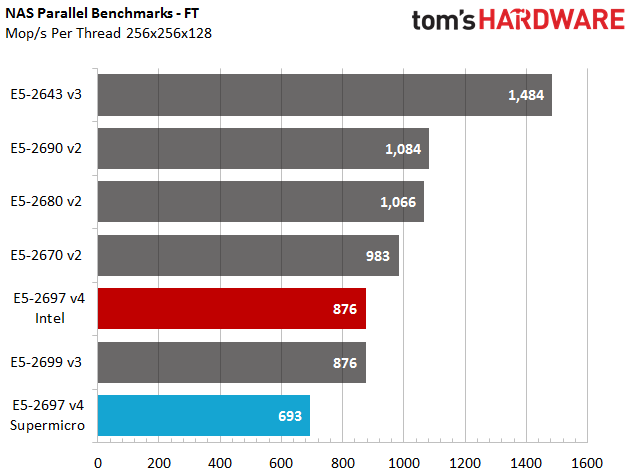
The two Xeon E5-2697 v4 configurations are closely matched in the 64x64x64 BT test, but the -2699 v3 noses in between them with an impressive score as well.
The Broadwell-EP-based processors in Intel's development platform perform as we'd expect them to, while the same Xeons in Supermicro's enclosure lose quite a bit of steam. This suggests that the test's more complex portion is influenced to some extent by system memory performance. After all, the Intel chassis is rocking 2400 MT/s DDR4, while the Supermicro platform uses more pedestrian 2100 MT/s RAM.
The M/ops per thread results indicate the performance of single cores during the test; they align with our expectations.
Redis
REmote DIctionary Server (Redis) is a popular in-memory data structure store that is used as a database, cache and message broker. It's dependent on both CPU performance and memory bandwidth. Redis is open source (BSD-licensed) software.
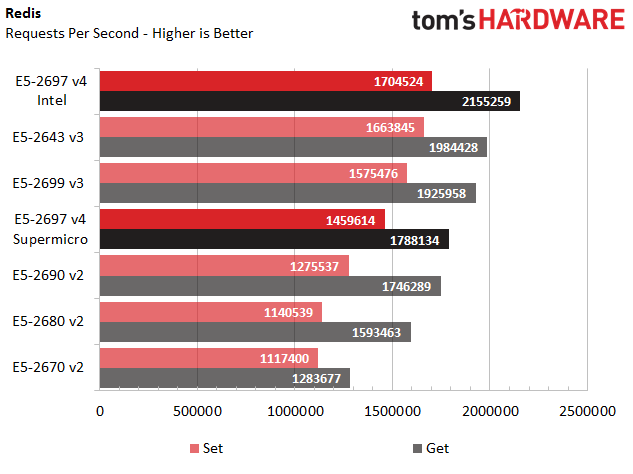

The Xeon E5-2697 v4s in Intel's chassis take the lead thanks to higher memory bandwidth than the Supermicro-based platform. We also tested the -2643 v3 and -2699 v3 processors in the Intel server, which explains their stellar performance in this benchmark. Clock rate clearly comes into play as well (the -2643 musters impressive performance). Meanwhile, the second-gen E5s based on Ivy Bridge languish at the bottom of the chart due, in part, to their DDR3 memory subsystem.
Open SSL
SSL (Secure Sockets Layer) is the go-to technology for securing encrypted links between a server and client. It's an important protocol for every level of the Web in today's security-conscious climate.
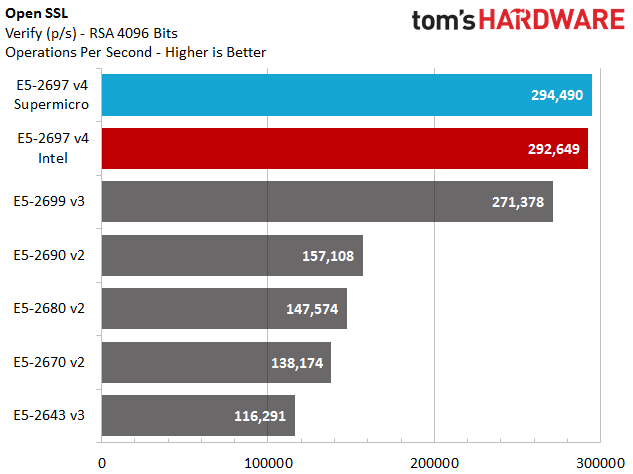
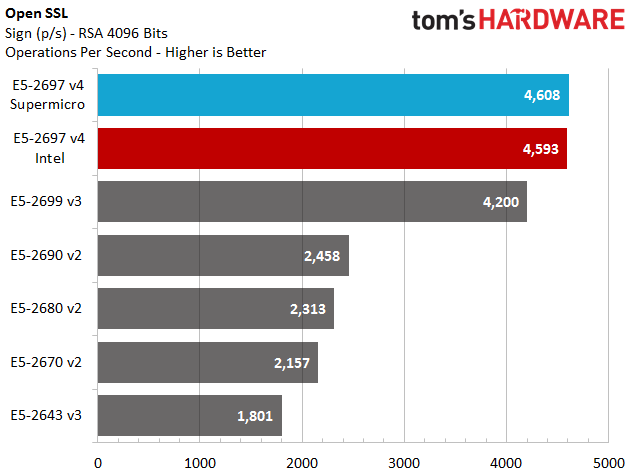
According to Intel, encryption/decryption performance was one of the Broadwell team's targets during the design phase, and the Xeon E5-2697 v4 demonstrates the results of those efforts. As you can see, our OpenSSL test utilizes multiple cores well.
Current page: Benchmarks
Prev Page Intel's 3D NAND SSD Debut: DC P3520/P3320 And DC3700/3600 Next Page Additional Benchmarks
Paul Alcorn is the Editor-in-Chief for Tom's Hardware US. He also writes news and reviews on CPUs, storage, and enterprise hardware.
-
utroz Hmm well we know that Broadwell-E chips must be coming very very soon if Intel let this info out.Reply -
bit_user Wasn't there supposed to be a 4-core 5.0 GHz SKU? Single-thread performance still matters, in many cases.Reply
-
turkey3_scratch Reply17746082 said:Wasn't there supposed to be a 4-core 5.0 GHz SKU? Single-thread performance still matters, in many cases.
In most server applications it doesn't matter as much as multithreaded performance. If you need single-core strength, getting a consumer chip is actually better, but you probably aren't running a server if single-threaded is your focus. -
PaulyAlcorn ReplyWasn't there supposed to be a 4-core 5.0 GHz SKU? Single-thread performance still matters, in many cases.
I read the rumors on that as well, but nothing official has surfaced as of yet to my knowledge. -
bit_user Reply
Try telling that to high-frequency traders. I'm sure they want the reliability features of Xeons (ECC, for example), but the highest clock speed available.17746141 said:17746082 said:Wasn't there supposed to be a 4-core 5.0 GHz SKU? Single-thread performance still matters, in many cases.
In most server applications it doesn't matter as much as multithreaded performance. If you need single-core strength, getting a consumer chip is actually better, but you probably aren't running a server if single-threaded is your focus.
And the fact that Intel even released low-core high-clock SKUs is an acknowledgement of this continuing need. Clock just not as high as I'd read. With the other specs basically matching the Haswell version, the only difference is ~5% IPC improvement. Seems pretty poor improvement, for a die-shrink.
-
firefoxx04 Would nice to have a quad core xeon that turbos at 4.4ghz just like the 4790k. I had to go with a 4690k when building an autocad system because it only uses one core and needs that core to be fast... this means i have to sacrifice ecc support.Reply -
bit_user Reply
On wccftech (not the most reliable source, I know), they claimed:17746160 said:Wasn't there supposed to be a 4-core 5.0 GHz SKU? Single-thread performance still matters, in many cases.
I read the rumors on that as well, but nothing official has surfaced as of yet to my knowledge.
Model: Intel Xeon E5-2602 V4
Cores/threads: 4/8
Base clock: 5.1 GHz
Turbo clock: TBD
L3 Cache: 5 MB
TDP: 165W
Given what we know about 2.5 MB/core of L3 Cache, the 5 MB figure sounds suspicious. It's conceivable they could disable some to hit the target TDP, I guess.
-
firefoxx04 We cant get skylake to consistently hit 5ghz... why would a xeon chip suddenly hit 5ghz?Reply -
JamesSneed Reply17746312 said:We cant get skylake to consistently hit 5ghz... why would a xeon chip suddenly hit 5ghz?
I'm not saying the 5Ghz rumor is true but Intel has always known which chips can hit higher clocks during certification if the chip is a top end or low end chip cores disabled etc. I'm sure they could cherry pick a few to sell for $$$ if they wanted. Now are they I have no real idea. -
bit_user Reply
Well, I was surprised, too.17746312 said:We cant get skylake to consistently hit 5ghz... why would a xeon chip suddenly hit 5ghz?
There are obviously things you can do in chip design that allow one to reach different timing targets. And I was hoping they might've refined their 14 nm process, since the time the first Broadwells launched. So, I thought, with more TDP headroom afforded by this socket (roughly double what Skylake has to work with), maybe they could do it.
I thought maybe Intel was addressing some pent-up demand for high clockspeed applications. That said, it seemed particularly odd in Broadwell, given that it generally seems oriented towards lower clockspeed / lower power applications.
But maybe it was a typo, or even a blatant lie, in order to track down leakers.
